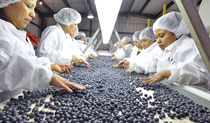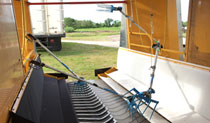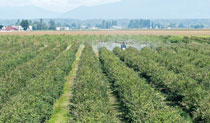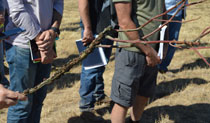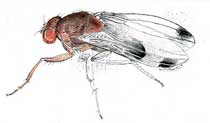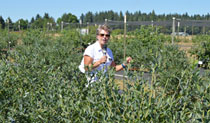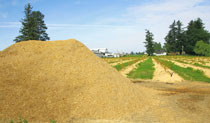Mini Blues for Hands-Off Production
 |
|
|
At the 2018 Blueberry Field Day, while standing in a plot of a cultivar released in 2017 named Mini Blues, Oregon State University professor and Extension Berry Specialist Bernadine Strik asked what many participants were probably thinking.
“Why on earth would you want to release something so tiny?” Strik asked.
“For the baking trade,” she answered.
The cultivar, developed by Chad Finn through the USDA Agricultural Research Service cooperative breeding program, offers a cultivated highbush alternative to the wild, lowbush blueberry that is widely used in baking, Strik said.
“Also, Strik said, “it is outstanding for flavor, and it is the smallest commercial variety available.”
In the trial, established in the fall of 2015, Strik said she is researching a “relatively hands-off system to grow Mini Blues.”
“We can barely afford to handpick our bigger fruited blueberries,” Strik said. “So, there is no handpicking this.”
The trial involves analyzing the effects of different pruning methods, including taking a year, two or even three years off from pruning, which, if possible, would significantly reduce growers’ labor needs and costs, Strik said.
“It is a huge advantage if we can go several years without pruning this cultivar,” she said.
Strik also is testing to see if plants can be economically machine harvested from the get go, something that looks like it could be a go. “These plants were machine harvested just once this season with great results,” Strik said.
Among preliminary trial results Strik aired on July 18, the best yield was 2.1 tons per acre, with an average machine harvested yield of just under 3,000 pounds per acre. “That is on three-year-old plants,” she pointed out.
She also noted that she did not see a huge disadvantage of not pruning last winter. “We still saw a very good yield. We still see very good growth,” she said. “So that looks promising.”
Also, despite being just three-year-old plants, the cultivar showed no ill effects from the harvester.
“Normally, I would not recommend coming into bushes that are this small, because it can rock the bush and damage the crown, but these are extremely well anchored, and I have seen no evidence of rocking. That is really good news about this particular variety,” she said.
“This variety machine picks outstandingly,” she said, noting there were very few stems in the picked fruit and very little green fruit.
Strik pointed out that there were losses from fruit ripening below the harvester’s catcher plates and being left on plants.
“That is a loss,” Strik said, “but you have losses when you handpick, too.”
| FALL 2018
|
